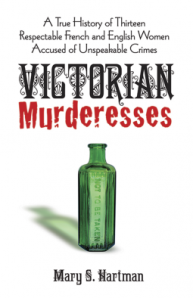
Historical Crime
5*’s
There is something quite fascinating about women who murder, and judging by the amount of contemporary reporting of the details about the cases featured in this book, nothing much has changed over time. In this book the author has selected an Englishwoman and a Frenchwoman for each chapter based upon the circumstances, rather than the method of their crimes. All the women featured are from the middle-classes and a certain amount of conjecture is used to paint a picture of this class of women from the details of their cases the reasoning of the author being that these women’s lives weren’t documented or studied in the way of the lower classes and so using these cause celebres can give us a glimpse behind the drawing room curtains of their lives. I’m not completely convinced by this argument but for some of the broader details it works, for instance the chapters that touch upon contraceptive gives us an idea of how widespread or acceptable this was in Victorian England for the middle-classes.
The beauty of this book is threefold; the details of the crimes committed the resulting investigation and if appropriate trial, the popular opinion at the time of the guilt or innocence of those accused using contemporary media and lastly the particular social issues that may have led these women to act outside the law and kill another person. Each case presented was interesting and appeared to be well-researched, although one of the downsides of reading this kind of book on the kindle is that following the notes as you go along is very time-consuming so I tended to wait until I’d finished a chapter to catch-up on these. The fact that there were two women per chapter means that the reader does need to concentrate once the initial setting of the scene has happened, as the author switches between the two subjects to compare and contrast the difference between the two societies in a number of different spheres, including popular opinion and expectations.
The author states in the preface:
These accused daughters, wives and mothers have little to teach any would-be twentieth-century practitioner about the art of murder; nearly all of them bungled badly in the ac, and those who got away with it relied upon methods that required special circumstances and relations between the sexes which no longer obtain.
And that is precisely what makes this study so interesting, women can no longer act coy in the witness box, but they could, and were expected to, in Victorian England and so many of the more salacious details are hinted at rather than baldly stated both at the trial and the resultant reporting.
The cases cover the years 1840-1890’s and the subjects covered are:
Marie Lafarge and Euphemie Lacoste which covers the use of arsenic in matriomony
Madeline Smith and Angelina Lemoine who were both between school and marriage when they were accused of killing their lovers
Celestine Doudet and Constance Kent who were both spinsters when they murdered
Florence Bravo and Henriette Francey the so called new women who were defying the old order of society
Gabrielle Fenayrou and Adelaide Bartlett both wives of shopkeepers who were reported to have committed adultery
Florence Maybrick and Claire Reymond who were allegedly victims of the double standards held at the time.
I found this book both interesting and informative although the language at time is quite dry, this is a study rather than a book for entertainment but one that I will be seeking a physical copy of on my bookshelf to supplement my Victorian crime selection.
This book was originally published back in 1976 but has been re-released in 2014 for a new generation of readers by Dover Publications who were kind enough to give me a copy of this book in return for my honest review.
My recommended further reading:
The Suspicion of Mr Whicher by Kate Summerscale – Constance Kent is the chief suspect in the The Murder at Road Hill House and features in chapter three of this book.
Death at the Priory by James Ruddick – The murder of Charles Bravo is the subject of this non-fiction book which explores all the possible culprits to this horrific murder by poison. (chapter four in this book)
A Very British Murder by Lucy Worsley – an excellent look at the fascination that we have with a ‘good murder’ and the reporting that fed this desire.


